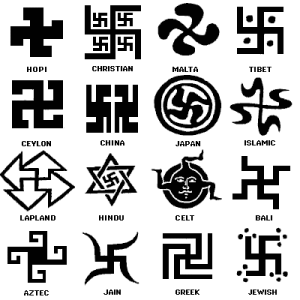 By: Omar Cherif / Source: Conscious Life News
By: Omar Cherif / Source: Conscious Life News
The swastika is an extremely powerful symbol. The Nazis used it to murder millions of people, but for centuries it had positive meanings.
This a brief history about that often-misunderstood symbol.
The swastika is an ancient symbol that has been used for over several thousand years – possibly even predateing the ancient Egyptian symbol, the Ankh. Artifacts such as pottery and coins from ancient Troy show that the swastika was a commonly used symbol as far back as 1000 BCE.
During the following thousand years, the image of the swastika was used by many cultures around the world, including in China, Japan, India, and southern Europe. By the Middle Ages, it was a well known, if not commonly used, symbol but was called by many different names:
China – wan
England – fylfot
Germany – Hakenkreuz
Greece – tetraskelion and gammadion
India – swastika
Though it is not known for exactly how long, Native Americans also have long used the symbol of the swastika.
The word “swastika” comes from the Sanskrit svastika – “su” meaning “good,” “asti” meaning “to be,” and “ka” as a suffix.
Until the Nazis used this symbol, the swastika was used by many cultures throughout the past 3,000 years to represent life, sun, power, strength, and good luck.
Even in the early twentieth century, the swastika was still a symbol with positive connotations. For instance, it was a common decoration that often adorned cigarette cases, postcards, coins, and buildings. During World War I, the swastika could even be found on the shoulder patches of the American 45th Division and on the Finnish air force until after World War II.
Then in the 1800s, countries around Germany were growing much larger, forming empires; yet Germany was not a unified country until 1871. So to counter the feeling of vulnerability and the stigma of youth, German nationalists in the mid-nineteenth century began to use the swastika, because it had ancient Aryan/Indian origins, to represent a long Germanic/Aryan history.
By the end of the nineteenth century, the swastika could be found on nationalist German volkisch periodicals and was the official emblem of the German Gymnasts’ League. And by the beginning of the twentieth century, it became a common symbol of German nationalism and could be found in a multitude of places such as the emblem for the Wandervogel, a German youth movement; on Joerg Lanz von Liebenfels’ antisemitic periodical Ostara; on various Freikorps units; and as an emblem of the Thule Society.
In 1920, Adolf Hitler decided that the Nazi Party needed its own insignia and flag. For wily Hitler, the new flag had to be “a symbol of our own struggle” as well as “highly effective as a poster.” (Mein Kampf, pg. 495)
And on August 7, 1920, at the Salzburg Congress, the red flag with a white circle and black swastika became the official emblem of the Nazi Party.
In Mein Kampf, Hitler described the Nazis’ new flag: “In red we see the social idea of the movement, in white the nationalistic idea, in the swastika the mission of the struggle for the victory of the Aryan man, and, by the same token, the victory of the idea of creative work, which as such always has been and always will be anti-Semitic.” (pg. 496-497)
Because of the Nazis’ flag, the swastika later became a symbol of hate, antisemitism, violence, death, and murder, after 3000 of being a symbol of life and good luck.
These conflicting meanings are causing problems in today’s societies. For Buddhists and Hindus, the swastika is a very religious symbol that is commonly used.
Unfortunately, the Nazis were so effective at their use of the emblem, that many do not even know any other meaning for the swastika. Can there be two completely opposite meanings for one symbol?
In ancient times, the direction of the swastika was interchangeable as can be seen on an ancient Chinese silk drawing. Some cultures in the past had differentiated between the clockwise swastika and the counter-clockwise sauvastika. In these cultures the swastika symbolized health and life while the sauvastika took on a mystical meaning of bad-luck or misfortune.
That’s why some people today are trying to differentiate the two meaning of the emblem by varying its direction; clockwise like the Nazis meaning hate and death, while the counter-clockwise version would hold the ancient meaning of life and good luck.
